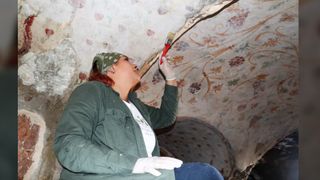From around 550 BCE to the age of Alexander the Great in the 330s BCE, each successive generation of Greeks had its own particular way of reconfirming, as needed, Hellenic identity against the ever-changing yet ever-present Persian threat. The Greek obsession with the Persians focused on minimizing their credibility as a superpower.
Denigration of the Persians—by vilification or lampooning—was intended to cauterize the wounds of anguish and fear provoked by the threats and realities of being neighbors of an empire whose territorial ambitions were very real and which showed no sign of ever abating.
In order to increase Greek morale, a series of what might be termed “cathartic” images were created on stage, in sculpture, and in the other arts. These disparaged, degraded, and belittled the Persians and confirmed Greek (especially Athenian) pre-eminence.
One such object is a red-figured wine-jug dated to the mid-460s BCE. Known as the “Eurymedon Vase,” it shows a humiliated Persian soldier bending forward from the waist. His backside is offered up to a grubby Athenian squaddie who stands with his erect penis in his hand, rushing forward in order to penetrate the Persian’s rear.
In order to increase Greek morale, a series of what might be termed “cathartic” images were created on stage, in sculpture, and in the other arts. These disparaged, degraded, and belittled the Persians and confirmed Greek (especially Athenian) pre-eminence.
One such object is a red-figured wine-jug dated to the mid-460s BCE. Known as the “Eurymedon Vase,” it shows a humiliated Persian soldier bending forward from the waist. His backside is offered up to a grubby Athenian squaddie who stands with his erect penis in his hand, rushing forward in order to penetrate the Persian’s rear.
The painted rape scene (for that’s what it is) was created as a “commemorative issue” at the time the Athenians celebrated a victory over Persian forces at the battle of the River Eurymedon in Asia Minor in 467 BCE. It was used at some kind of drinking party, probably a soldiers’ get-together. As the jug was passed around a group of hoplites—the Greek equivalent of GIs—so the wine flowed and the dirty jokes began to fly. So too was the Persian on the vase manhandled from soldier to soldier.
As each drinker gripped the jug, he replayed the drama of the scene: “Now I am Eurymedon,” he boasted. “Look at me, buggering this Persian!” The vase image is a perceptive visualization of soldiers’ humor, although it is highly likely that the scene reflected a lived reality.
As each drinker gripped the jug, he replayed the drama of the scene: “Now I am Eurymedon,” he boasted. “Look at me, buggering this Persian!” The vase image is a perceptive visualization of soldiers’ humor, although it is highly likely that the scene reflected a lived reality.
After all, the post-battle rape of defeated soldiers has never been just a drinking-game fantasy. The Eurymedon vase was an expression of the Athenian zeitgeist of the 460s BCE. It was a well-aimed joke on recent unexpected but fortuitous political and military events which demonstrated the natural superiority of the Greeks over the barbarian Persians. READ MORE...

